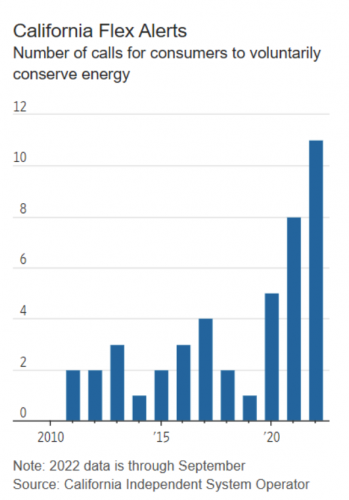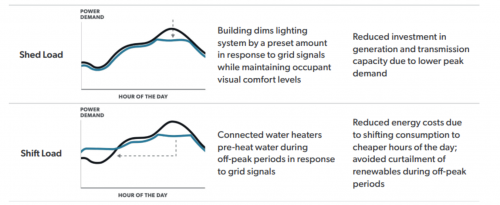Demand Response and Rate Reform
Background on Demand Response
Electricity suppliers must closely match supply and demand on a second-by-second basis to prevent disruption of service on the grid. Utilities traditionally used flexible generators to raise or lower output as needed. In recent years, however, more and more utilities have explored demand-side alternatives. Getting customers to voluntarily reduce peak demand even a few hours a year when supplies run short, for example, can prevent rotating outages or regional blackouts and reduce system costs.

This category of programs is called “Demand Response” or DR. California’s Public Utilities Commission defines DR as “reductions, increases, or shifts in electricity consumption by customers in response to their economic signals or reliability signals.” About 11 million U.S. residential customers, a quarter million commercial customers, and 40,000 industrial customers engage in DR programs.
Benefits of DR include savings on the construction of new power plants and transmission to meet periods of peak demand that sometimes last just a few hours a year. With the savings, utilities can offer customers lower rates or payments to shave their demand or shift its timing. As we’ll see, DR can also support progress toward net zero carbon emissions in the power sector.
DR can take many forms. One of the most basic is a simple public plea from the utility to customers to save energy during a supply crisis. Many utilities offer “time of use” rate plans that charge more during periods of high demand, such as summer afternoons, in exchange for lower rates in late night and early morning hours. More specialized DR programs pay industrial, commercial, and agricultural customers to temporarily reduce demand for refrigeration, irrigation, water heating, or other functions when called upon.
Two ways demand response can support grid reliability and lower costs Source: Department of Energy
How Demand Response supports a clean and stable electric grid
The power plants that DR supplants are typically gas-fired “peakers” that emit carbon pollution. A 2014 study by the consulting firm Navigant found that Demand Response programs could directly cut up to about 2% of system CO2 emissions and “should be a key component of any regulation of carbon dioxide pollution.”
In the summer of 2022, pleas from power grid operators in Texas and California prevented widespread outages as temperatures soared into triple digits. The chief of California’s electric grid praised customers for dropping 4% of system load in half an hour, saying it “made an enormous difference in our efforts to keep the power flowing.” That drop was roughly equal to the power capacity of three modern natural gas power plants.
Besides reducing pollution from gas “peaker” plants, flexible DR can support the affordable integration of more variable wind and solar power onto the grid. When renewable output is too high and would otherwise be wasted, utilities can signal participating customers to take more power (for example, to precool their buildings on hot days or to charge their vehicles). When renewable output dips too low, DR programs can enlist customers to back off their demand to help balance on the grid.
Last but not least, smart technologies that support demand flexibility, such as heat pumps, can help utilities meet the challenge of rising demand from the electrification of vehicles and buildings. Such electrification, using clean resources, will be a major source of economy-wide decarbonization in years to come if managed properly. The National Renewable Energy Laboratory (NREL) warns that “without demand-side flexibility, electrification can result in load profiles that could lead to greater challenges and costs.” With higher levels of demand flexibility, on the other hand, the U.S. could reduce annual carbon emissions between 44 and 59 million tons per year by 2035.
Issues with Demand Response
DR programs require active customer engagement, but their complexity often breeds confusion and resistance. Although nearly two-thirds of U.S. electricity customers have access to time-of-use rate plans that would reward them for shifting energy use to periods of low demand, only about 7% take advantage of them. Fortunately, as automatic control technologies like smart thermostats become more common, customers will be able to save money without having to think about behavior choices. For now, however, the integration of such technologies into power networks remains in its infancy.
Another factor holding up acceptance is the meager reward consumers sometimes enjoy for cooperating. “By failing to pay people for the services their distributed energy resources can provide,” one energy journalist remarked, states risk “seeing a valuable set of demand-side resources fail to show up when the grid could use it — and spending far more money than might otherwise be needed on imported power and utility-scale infrastructure to make up the difference.”
DR has few intrinsic drawbacks as an alternative to fossil generation, but it has practical limits. Princeton energy modeler Jesse Jenkins praised DR for providing “short bursts of flexibility that can help better align supply and demand with . . . variable wind and solar resources,” but added, “the problem . . . is that you can’t really sustain their output for a long period of time. You might be willing to participate in that flex alert from 6 p.m. to 10 p.m. on a couple of really hot days, but you’re not going to do that every day for a month.”
How much could Demand Response contribute to a clean and stable electric grid?
Thanks to its untapped potential for complementing the growth of renewable energy, most scenarios for decarbonizing the U.S. electric grid see a robust role for DR:
- Energy Innovation projects that the United States will need about 100 gigawatts (GW) of DR capacity to meet its commitment to reduce carbon emissions 50% by 2030. Although that figure is more than three times the current DR capacity, it should be readily achievable. A respected 2019 study concluded that the United States could support 200 GW of DR capacity by 2030 with annual benefits of more than $15 billion per year.
- A more ambitious roadmap to 100% clean electricity by 2035, published by NREL in 2022, based its default scenario in part on the ability to reduce U.S. power demand as much as 246 GW for short periods of time.
The exact numbers don’t really matter. The bottom line is the country needs—and would benefit from—a lot more DR to support its decarbonization goals. The way to get there is to provide the right customer and utility incentives, improve marketing and education, and continue developing cost-effective technology to help integrate home and business energy management systems with grid operations.
Other FAQs
What role will automation and EV charging play in the future of Demand Response?
Automation can help make DR even more valuable to utilities. For example, some pay customers with smart thermostats to let them remotely turn down air conditioners on hot afternoons. Heat pumps can provide similar services during winter heating days. Utilities may soon pay customers with electric vehicles to postpone charging for a spell to spare the grid, while still allowing them to charge fully over the course of a day. As technology improves, EV batteries could send power back to the grid when wholesale prices are high, earning customers a tidy profit.
How does Demand Response relate to “virtual power plants”?
RMI defines a virtual power plant as “a collection of small-scale energy resources that, aggregated together and coordinated with grid operations, can provide the same kind of reliability and economic value to the grid as traditional power plants.” A virtual power plant can be created by companies that direct the operation of smart appliances, EV and home batteries, and rooftop solar resources among thousands of households and businesses to provide utilities with flexible demand and energy supply. In this way they can help balance the grid much like a power plant. Virtual power plants represent an extension of the concept of demand response, since the energy supplies customers provide (for example, from solar or battery discharges) look to the utility like a reduction in customer demand.
